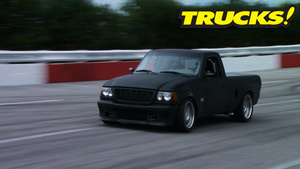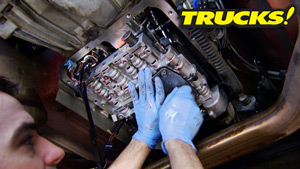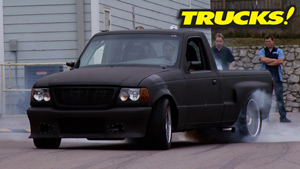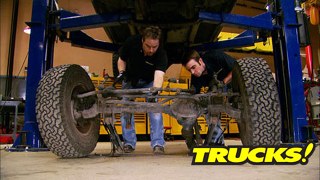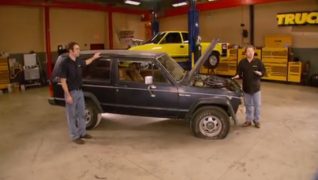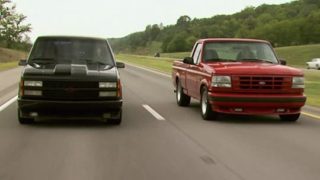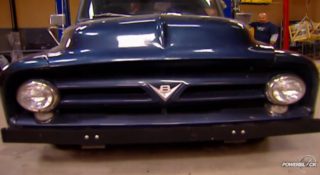More '98 Jeep Grand Cherokee Episodes
Trucks! Builds
Want more content like this?
Join the PowerNation Email NewsletterParts Used In This Episode
BF Goodrich
315/75R16 BFGoodrich Mud-Terrain KM2.
Bilstein
Fixed reservoir 5150 shocks.
Classic Parts of America
For all you Classic Chevy Truck owners you are probably familiar with the original 1955-59 Gauge Cluster. Well, Classic Parts of America now offers a new spin on the Gauge Assembly for your 1955-59 Task Force Chevy Truck. This New, Upgraded assembly is a complete retrofit unit, incorporating a tachometer and LED lighting, while still retaining the original look. The Tach-Force features a dual layer design, 12-volt electronic movements, and push button calibration. The unit is available in Bl
Classic Parts of America
Specializing in Chevy Parts and Accessories for 1947-1998 Chevrolet and GMC Pickup Trucks.
Currie Enterprises
Front axle assembly, ARB air locker, 4.56 gears.
Currie Enterprises
Rear axle assembly, ARB airlocker, 4.56 gears, explorer disc brake set, cables and yoke.
EMS Offroad,LLC
D.I.Y. Complete spare tire kit.
Norton Automotive Refinishing Products
SpeedGrip Structural Adhesive.
Rusty's Off Road
Suspension lift kit, 5.5" Long arm system, transfer case skid plate, fuel tank skid plate, tie rod end and drag link.
The Eastwood Company
2K Ceramic Chassis Black, Spray Max 2K urethane aerosol high-gloss clearcoat, Spra-Tool paint sprayer.
Tom Wood's Custom Drive Shafts
Our drive shafts are built on a reputation for quality workmanship, product knowledge, warranty and customer service. Tom Wood's Custom Drive Shafts Inc. will continue to build the absolute best quality drive shafts available anywhere at an affordable price. Because of the variables from stock to the endless variety of custom modifications on today's vehicles, we manufacture each drive shaft one at a time to suit your needs, not ours. We have developed a unique ordering system that makes orderin
Torchmate CNC Cutting Systems
Torchmate 2, 4ft. x 4ft. Light industrial table, Thermal Dynamics Cutmaster 101.
Episode Transcript
Today, we're back to work on our project five Grand Cherokee first, we're cutting out room for our new suspension flex and showing you how to keep the factory look for cheap and we'll add some heavy duty rocker skids, homemade bumpers and a tire rack. And finally it's a new trucks project inspired by this.
Oh, yeah,
it's all today here on trucks.
Hey, welcome to trucks. Well, today we're back on our Grand Cherokee project. Our 5.5 inch suspension lift on our axle swap is pretty much in place. This thing's almost ready for the road, but it's not quite ready for the trail yet.
There's still a little bit of body armor to put on this sink.
But before we do that, we want to show you guys a few of the changes we made since you saw it last now for the axles. Well, after we stripped them down to bare steel, we hit them with a couple of coats of a high strength ceramic paint we got from the Eastwood Company and
is to change things up a bit. Well, we painted the wheels to match
if you guys remember these wheels used to be just painted steel. So we scuffed them up and shot them and this ceramic coating looks great. It looks like powder coat and it's almost as strong, but we didn't use a brush. We sure didn't use a roller and we didn't use a conventional pneumatic paint gun. What we used to paint these is this guy, this is a dedicated self contained air supply that you can put any kind of paint in. We're going to use this again on the body panel. So you want to keep watching for that. Now, with the knuckle swap
up front, we had a,
the
challenges to take care of the track bar. We fabricated a new bracket using our torch mate for the steering linkage. Well, we gave our measurements to Rusty's off road and they hooked us up with a heavy duty drag link and tie rod, both outfitted with
hem joints,
but we still had a clearance issue with our diff cover. So we notched that for maximum clearance as well as put a couple of slight bends in the tie rod. And that took care of that problem since we were up here also through an a steering stabilizer. And for you guys that notice we didn't have a run sway bar. Well, don't worry, we will. And like we told you, we would, we already installed an NP 231 transfer case. This will give us the ability to run in two wheel drive instead of being stuck with the stock full time, four wheel drive set up, this one's already got the slip Yoke Eliminator installed and only cost us 100 bucks now to make it work. Basically, all we had to do was swap the stock input gear from the original transfer case into our new one, slight modification of the shift linkage finished out the swap.
Now, turning those 35 inch mud terrains with a healthy V8 is going to take some serious drive shafts and the front shaft features this weaker CV design.
So a call to Tom Wood's custom drive shafts got us fixed up with these replacements based on the measurements that we sent in. They feature their gold seal greaser
U joints with an easy look at polish finish and they're fully balanced with a warranty.
Tom Woods, not only warranties, the U joints against failure, he'll also cover damage to the drive shaft. Should the U joints fail?
All right. It's just about time to see how much sheet metal we're going to need to trim to keep our BFGS out of our fenders. But before we flex out the suspension, we're going to use these ratchet straps
as temporary limiting straps. So we don't overextend our bill. Stein shocks.
The extended length of our shocks is 29.5 inches
knowing that we can stop droop just short of that and measure for permanent limiting straps and bump stops.
We know these stock bumper covers are not getting reused and they are in good condition. So we're going to try and sell them along with the rocker molding to make a few bucks back.
Ok. Well, that stuff out of the way now we can set this thing down on these tires stacked at opposite corners and test for suspension flex as well as see how much trimming we got to do on those outer wheelhouses.
Now, the Jeep's body is almost completely level, but check out the flex and the suspension.
That's the kind of articulation that 5.5 inches of lift and a good long arm kit are going to get you. Now right here, if we engineer a little bit of radius into our wheel arch with our bumper design, we'll be ok for clearance here.
But back here, well, it's pretty obvious unless we plan on wheeling in a straight line, we got to do some trimming. Now, back here, it doesn't look like we're going to have to cut any metal. Of course, our bumpers are going to have to be designed to clear, but we're not going to have to trim any out of our rockers. We're going to cut them up anyway,
while Ryan's creating a little bit of extra tire clearance, I'm going to go and pick up our next trucks project and believe me, you guys are not going to want to miss this one because it's unique in the fact that we've never done one on trucks before. And as far as we know the build process for one of these vehicles has never been documented on television before. So while Ryan takes care of our fender clearance issue, we're going to give you guys an inside look at one of the most therapeutic motor sports ever conceived. You don't want to miss this.
We know that about an inch and a half of clearance needs to be added.
Using the tape, lets us choose a radius and draw guidelines while protecting the paint from markers and tools,
extra stuff.
The inner fender needs to be trimmed back as well.
A
few relief cuts on the pinch belt allow us to fold back the metal without having to tub the whole wheelhouse.
Of course, a little persuasion with a big hammer helps too.
All right, let it down.
Now, as you can see, we've got about 38 of an inch clearance just enough. But before we finish these fenders out,
we're gonna get cutting on these rockers.
Our rocker panels are boxed sheet metal sections connected to the outside of the frame rails and are designed to add strength to the vehicle, but they're made out of the same 22 gauge sheet metal that the rest of the body is
the outer skin is all that will remove. So you've got an opportunity to increase the rigidity of the unibody and add protection to the body side as well.
We're adding two by four rectangular tubing with an eight inch wall thickness.
Reliefs are cut into the tubing to allow for the inner structure.
This way, you don't have to undo strength. The Jeep is already engineered into the unibody
blocking the tubing may seem like a waste of time, but it just adds rigidity to what we're installing.
Adding the rectangular tube into the rockers, doubles the wall thickness and overall strength of these panels, but it's only half of the equation.
It also gives you a solid foundation and the ability to mount additional skids and bars to your now much stronger rocker panels so you can protect that sheet metal and paint
up. Next, we'll finish our rocker skids and add our tire rack and later, Tommy's taking us to the derby. Our kind of derby do not go away.
Hey, welcome back to the shop, Tommy and I are in here thrashing on our Grand Cherokee while Kevin's out searching for our next trucks project.
Right now, we're in the process of getting our rectangular rocker panels welded in for a little extra protection on the trail. So while Tommy gets another round of tack welding done, I'm going to bend up some tube to add to the rockers and we're going to go with inch and a half tubing with a wall thickness of 3/16 of an inch.
This thicker tube will be a lot less likely to get dents and dings from things like rock ledges or shopping carts. Now bending the thicker tube is a little more difficult but nothing leverage can overcome.
Now, here's a tip for you. If you've got seams in your concrete floor, you can use it as a giant square to help you figure things out.
Be sure to use a level to keep your bends on the same plane.
On top of the already thicker walls of the new Rockers.
Tommy's using 18 inch plate to add even more strength.
The openings add a little style and the plating doubles the wall thickness without adding excess weight.
The dom tubing gets attached at an angle to maintain ground clearance without it being in the way when getting in and out of the Jeep,
we got a transfer case skid plate from Rusty's when we ordered the rest of the lift
and it's made for Z J's with the 231 installed.
Now, when we were looking around for aftermarket bumpers, when we found plenty of good designs and good options. The problem was we couldn't find exactly what we wanted. So we made our own and here's what we got so far.
It utilizes a heavy duty 3/16 2 by three sub frame,
an eight inch plate seal cut out using our torch mate.
Now, we also added a receiver hitch as well as welded in some dr mounts that are tied to the sub frame.
Now, while this bumper looks done. Well, we still want to free up some room inside our Jeep by relocating the spare tire to the outside.
Now, usually that means forking over a bunch of dough for an aftermarket tire carrier. Well, Ems off road has a complete kit that includes everything. You need to add a swing out tire carrier to your bumper. It comes with the latch assembly, an isolator spindle bearings, tire mounting plate, they even throwing some pretty serious clevis mounts.
The EMS kit gives you the option of placement.
So we cut out some mounting plates out of eight inch metal based on the dimensions of the hardware to locate the pivot and the lash assembly,
we wanted to mount our hinge on the driver's side. So to make a little room for our isolator and our latch, I cut out this recess. Once we figure out where we want our latch, I'll finish boxing it in
the wheel and tire weighs in at an even 100 pounds. So it's up to you to give the tire rack the support it needs
inch and a half dom tubing will be strong enough to support the weight and it's relatively easy to work with.
We're using a protective welding paper on the glass and painted panels.
You can get this from almost any welding supply store or you could just use a welding blanket instead.
Now you can see from this angle just how vulnerable the fuel tank is
to keep our plastic tank protected. We're using this heavy duty skid again from rusty.
It's 3/16 of an inch and powder coating. So it should stay looking good for a while
after the break just because something's chopped up doesn't mean it has to look like it.
Hey, welcome back to trucks. Well, I have found the perfect vehicle for the next trucks project and we'll show you that in a few minutes. But right now, hey, Tommy and Ry have been kicking butt while I was gone, gotten a lot of work done. For instance, this fender, what they did is basically take a V cut or a section out of the sheet metal, bring the factory edge back in, welded it up and metal finished it. We've got a nice factory peering edge with a correct radius
and if this was some bomb can bush buggy, well, we'd hit that with some primer and hit the trail. But we told you all along, we want to keep the nice factory appearance to this rig since it's dual purpose. So that means sectioning our body style moldings,
which is basically the same drill. We cut a section, join the pieces back together, but this is plastic. So you can't just grab the mig welder and stitch it up like we did in the fender. But here's what you can do.
Now, you do have options when it comes to repairing plastic. But one of the best ways I've found to do this type of repair is with a structural adhesive like this Norton speed grip. It's a two part adhesive that intermixes in the tip and it's very strong. But we're also going to be using this netting to give it a little bit more structural rigidity and back. Our repair
duct tape is strong enough to hold our plastic together in the form we want to keep
and acts as a temporary panel, clamp,
the structural adhesive mixes in the tip and depending on the set speed that you choose, it'll stay workable for plenty of time.
I'm coating the entire repair area so the netting can integrate with the adhesive and form a strong backing, making a permanent repair.
Now, this is where it pays off wearing gloves. Once this adhesive dries, it ain't coming off your skin and this can get a little messy.
That's important to let your adhesive sit until it's dry. This is a five minute set time, but it takes about an hour to drive fully. But while we wait, let me show you what the finish work looks like
right here. Here's our backing. This stuff is hard as a rock and it's a very effective repair on the front. I've used a little bit of finishing putty and some spray can primer. This dude is ready for final paint.
So we'll clean them up with some aerosol prep spray. And since this is a metallic color, I'll stop with a finer gray pad, which is about a 500 grid equivalent
with the moldings prepped and cleaned. Now we're ready to paint them
and I've already mixed up some factory color off of the door tag. So we know we're going to get a good color match. But like we told you before, we're not using a roller, we're not using a brush and we're not using conventional pneumatic professional spray equipment. What we are using is this spray tool we got from the Eastwood Company. It's its own self contained air supply
that comes with a reservoir that you can put whatever type of paint that you want to spray.
You
got three different dedicated fluid tips from small to a larger size. We're gonna use the larger one because we want a large droplet size with our paint.
Now, you might want to think twice about painting your whole car with one of these, but for small parts and detail work, this works great.
The clear coat also comes from Eastwood and is way cool. It actually has a hardener in a sealed off section.
When you break the membrane, it intermixes and viola. You have professional quality catalyzed clear coat
in a bomb can no TV. Magic here guys, when you get professional results without breaking out the expensive toys, that's just plain cool
when we come back. It's a new project truck. So why are we showing you this?
Well, stick around.
Hey, Welcome back to trucks. Well, we've been talking about a brand new project vehicle and
here it is.
Well, what do you think? It's got no engine, no transmission. Even the drive shafts laying under a pile of junk in the bed. Yeah, this 79 Chevy is in rough shape. It's missing some glass. It's got crappy paint.
Little to no interior to speak of. And it's
been abandoned for at least five years.
Well, our buddy Mark Garner told Tommy about it. Well, Tommy told me about it and by the time I went to go look at this, I knew that for 300 bucks, this truck was perfect and just in case he was wondering what we're gonna do with this big pile of junk. Check this out.
I
know what you're thinking. These are cars, we've got a truck show, we're gonna build one of these, but with our spin
now, you guys may not realize this, but Tommy over here, Derby is on a regular basis and actually brings some money home. So we're going to rely on his expertise through the course of this bill. We are calling this the truck's ultimate resurrected Derby machine. And over the next few weeks, you're going to see us wrenching on this thing. Well, knit up, throwing a drive train in and making this truck strong enough to kick some derby butt.
Who knows? We might even polish it. So, like we said before, you have to keep watching because this is something you do not want to miss.
Hey, if you've got a 47 through 98 Chevy or GMC truck and you're looking for parts.
Well, I bet you can find them in here.
This is classic parts of America's line of Chevy and GMC truck parts catalogs. They're broken down into the basic body styles, for instance, 47 to 5455 to 5960 to 66 and so on.
And you can find just about anything you need in here to keep your classic truck in top condition. Classic truck parts of America's truck parts catalogs are free and you can order them online at Classic parts.com.
Thanks for watching trucks. See you guys next week.
Show Full Transcript
Oh, yeah,
it's all today here on trucks.
Hey, welcome to trucks. Well, today we're back on our Grand Cherokee project. Our 5.5 inch suspension lift on our axle swap is pretty much in place. This thing's almost ready for the road, but it's not quite ready for the trail yet.
There's still a little bit of body armor to put on this sink.
But before we do that, we want to show you guys a few of the changes we made since you saw it last now for the axles. Well, after we stripped them down to bare steel, we hit them with a couple of coats of a high strength ceramic paint we got from the Eastwood Company and
is to change things up a bit. Well, we painted the wheels to match
if you guys remember these wheels used to be just painted steel. So we scuffed them up and shot them and this ceramic coating looks great. It looks like powder coat and it's almost as strong, but we didn't use a brush. We sure didn't use a roller and we didn't use a conventional pneumatic paint gun. What we used to paint these is this guy, this is a dedicated self contained air supply that you can put any kind of paint in. We're going to use this again on the body panel. So you want to keep watching for that. Now, with the knuckle swap
up front, we had a,
the
challenges to take care of the track bar. We fabricated a new bracket using our torch mate for the steering linkage. Well, we gave our measurements to Rusty's off road and they hooked us up with a heavy duty drag link and tie rod, both outfitted with
hem joints,
but we still had a clearance issue with our diff cover. So we notched that for maximum clearance as well as put a couple of slight bends in the tie rod. And that took care of that problem since we were up here also through an a steering stabilizer. And for you guys that notice we didn't have a run sway bar. Well, don't worry, we will. And like we told you, we would, we already installed an NP 231 transfer case. This will give us the ability to run in two wheel drive instead of being stuck with the stock full time, four wheel drive set up, this one's already got the slip Yoke Eliminator installed and only cost us 100 bucks now to make it work. Basically, all we had to do was swap the stock input gear from the original transfer case into our new one, slight modification of the shift linkage finished out the swap.
Now, turning those 35 inch mud terrains with a healthy V8 is going to take some serious drive shafts and the front shaft features this weaker CV design.
So a call to Tom Wood's custom drive shafts got us fixed up with these replacements based on the measurements that we sent in. They feature their gold seal greaser
U joints with an easy look at polish finish and they're fully balanced with a warranty.
Tom Woods, not only warranties, the U joints against failure, he'll also cover damage to the drive shaft. Should the U joints fail?
All right. It's just about time to see how much sheet metal we're going to need to trim to keep our BFGS out of our fenders. But before we flex out the suspension, we're going to use these ratchet straps
as temporary limiting straps. So we don't overextend our bill. Stein shocks.
The extended length of our shocks is 29.5 inches
knowing that we can stop droop just short of that and measure for permanent limiting straps and bump stops.
We know these stock bumper covers are not getting reused and they are in good condition. So we're going to try and sell them along with the rocker molding to make a few bucks back.
Ok. Well, that stuff out of the way now we can set this thing down on these tires stacked at opposite corners and test for suspension flex as well as see how much trimming we got to do on those outer wheelhouses.
Now, the Jeep's body is almost completely level, but check out the flex and the suspension.
That's the kind of articulation that 5.5 inches of lift and a good long arm kit are going to get you. Now right here, if we engineer a little bit of radius into our wheel arch with our bumper design, we'll be ok for clearance here.
But back here, well, it's pretty obvious unless we plan on wheeling in a straight line, we got to do some trimming. Now, back here, it doesn't look like we're going to have to cut any metal. Of course, our bumpers are going to have to be designed to clear, but we're not going to have to trim any out of our rockers. We're going to cut them up anyway,
while Ryan's creating a little bit of extra tire clearance, I'm going to go and pick up our next trucks project and believe me, you guys are not going to want to miss this one because it's unique in the fact that we've never done one on trucks before. And as far as we know the build process for one of these vehicles has never been documented on television before. So while Ryan takes care of our fender clearance issue, we're going to give you guys an inside look at one of the most therapeutic motor sports ever conceived. You don't want to miss this.
We know that about an inch and a half of clearance needs to be added.
Using the tape, lets us choose a radius and draw guidelines while protecting the paint from markers and tools,
extra stuff.
The inner fender needs to be trimmed back as well.
A
few relief cuts on the pinch belt allow us to fold back the metal without having to tub the whole wheelhouse.
Of course, a little persuasion with a big hammer helps too.
All right, let it down.
Now, as you can see, we've got about 38 of an inch clearance just enough. But before we finish these fenders out,
we're gonna get cutting on these rockers.
Our rocker panels are boxed sheet metal sections connected to the outside of the frame rails and are designed to add strength to the vehicle, but they're made out of the same 22 gauge sheet metal that the rest of the body is
the outer skin is all that will remove. So you've got an opportunity to increase the rigidity of the unibody and add protection to the body side as well.
We're adding two by four rectangular tubing with an eight inch wall thickness.
Reliefs are cut into the tubing to allow for the inner structure.
This way, you don't have to undo strength. The Jeep is already engineered into the unibody
blocking the tubing may seem like a waste of time, but it just adds rigidity to what we're installing.
Adding the rectangular tube into the rockers, doubles the wall thickness and overall strength of these panels, but it's only half of the equation.
It also gives you a solid foundation and the ability to mount additional skids and bars to your now much stronger rocker panels so you can protect that sheet metal and paint
up. Next, we'll finish our rocker skids and add our tire rack and later, Tommy's taking us to the derby. Our kind of derby do not go away.
Hey, welcome back to the shop, Tommy and I are in here thrashing on our Grand Cherokee while Kevin's out searching for our next trucks project.
Right now, we're in the process of getting our rectangular rocker panels welded in for a little extra protection on the trail. So while Tommy gets another round of tack welding done, I'm going to bend up some tube to add to the rockers and we're going to go with inch and a half tubing with a wall thickness of 3/16 of an inch.
This thicker tube will be a lot less likely to get dents and dings from things like rock ledges or shopping carts. Now bending the thicker tube is a little more difficult but nothing leverage can overcome.
Now, here's a tip for you. If you've got seams in your concrete floor, you can use it as a giant square to help you figure things out.
Be sure to use a level to keep your bends on the same plane.
On top of the already thicker walls of the new Rockers.
Tommy's using 18 inch plate to add even more strength.
The openings add a little style and the plating doubles the wall thickness without adding excess weight.
The dom tubing gets attached at an angle to maintain ground clearance without it being in the way when getting in and out of the Jeep,
we got a transfer case skid plate from Rusty's when we ordered the rest of the lift
and it's made for Z J's with the 231 installed.
Now, when we were looking around for aftermarket bumpers, when we found plenty of good designs and good options. The problem was we couldn't find exactly what we wanted. So we made our own and here's what we got so far.
It utilizes a heavy duty 3/16 2 by three sub frame,
an eight inch plate seal cut out using our torch mate.
Now, we also added a receiver hitch as well as welded in some dr mounts that are tied to the sub frame.
Now, while this bumper looks done. Well, we still want to free up some room inside our Jeep by relocating the spare tire to the outside.
Now, usually that means forking over a bunch of dough for an aftermarket tire carrier. Well, Ems off road has a complete kit that includes everything. You need to add a swing out tire carrier to your bumper. It comes with the latch assembly, an isolator spindle bearings, tire mounting plate, they even throwing some pretty serious clevis mounts.
The EMS kit gives you the option of placement.
So we cut out some mounting plates out of eight inch metal based on the dimensions of the hardware to locate the pivot and the lash assembly,
we wanted to mount our hinge on the driver's side. So to make a little room for our isolator and our latch, I cut out this recess. Once we figure out where we want our latch, I'll finish boxing it in
the wheel and tire weighs in at an even 100 pounds. So it's up to you to give the tire rack the support it needs
inch and a half dom tubing will be strong enough to support the weight and it's relatively easy to work with.
We're using a protective welding paper on the glass and painted panels.
You can get this from almost any welding supply store or you could just use a welding blanket instead.
Now you can see from this angle just how vulnerable the fuel tank is
to keep our plastic tank protected. We're using this heavy duty skid again from rusty.
It's 3/16 of an inch and powder coating. So it should stay looking good for a while
after the break just because something's chopped up doesn't mean it has to look like it.
Hey, welcome back to trucks. Well, I have found the perfect vehicle for the next trucks project and we'll show you that in a few minutes. But right now, hey, Tommy and Ry have been kicking butt while I was gone, gotten a lot of work done. For instance, this fender, what they did is basically take a V cut or a section out of the sheet metal, bring the factory edge back in, welded it up and metal finished it. We've got a nice factory peering edge with a correct radius
and if this was some bomb can bush buggy, well, we'd hit that with some primer and hit the trail. But we told you all along, we want to keep the nice factory appearance to this rig since it's dual purpose. So that means sectioning our body style moldings,
which is basically the same drill. We cut a section, join the pieces back together, but this is plastic. So you can't just grab the mig welder and stitch it up like we did in the fender. But here's what you can do.
Now, you do have options when it comes to repairing plastic. But one of the best ways I've found to do this type of repair is with a structural adhesive like this Norton speed grip. It's a two part adhesive that intermixes in the tip and it's very strong. But we're also going to be using this netting to give it a little bit more structural rigidity and back. Our repair
duct tape is strong enough to hold our plastic together in the form we want to keep
and acts as a temporary panel, clamp,
the structural adhesive mixes in the tip and depending on the set speed that you choose, it'll stay workable for plenty of time.
I'm coating the entire repair area so the netting can integrate with the adhesive and form a strong backing, making a permanent repair.
Now, this is where it pays off wearing gloves. Once this adhesive dries, it ain't coming off your skin and this can get a little messy.
That's important to let your adhesive sit until it's dry. This is a five minute set time, but it takes about an hour to drive fully. But while we wait, let me show you what the finish work looks like
right here. Here's our backing. This stuff is hard as a rock and it's a very effective repair on the front. I've used a little bit of finishing putty and some spray can primer. This dude is ready for final paint.
So we'll clean them up with some aerosol prep spray. And since this is a metallic color, I'll stop with a finer gray pad, which is about a 500 grid equivalent
with the moldings prepped and cleaned. Now we're ready to paint them
and I've already mixed up some factory color off of the door tag. So we know we're going to get a good color match. But like we told you before, we're not using a roller, we're not using a brush and we're not using conventional pneumatic professional spray equipment. What we are using is this spray tool we got from the Eastwood Company. It's its own self contained air supply
that comes with a reservoir that you can put whatever type of paint that you want to spray.
You
got three different dedicated fluid tips from small to a larger size. We're gonna use the larger one because we want a large droplet size with our paint.
Now, you might want to think twice about painting your whole car with one of these, but for small parts and detail work, this works great.
The clear coat also comes from Eastwood and is way cool. It actually has a hardener in a sealed off section.
When you break the membrane, it intermixes and viola. You have professional quality catalyzed clear coat
in a bomb can no TV. Magic here guys, when you get professional results without breaking out the expensive toys, that's just plain cool
when we come back. It's a new project truck. So why are we showing you this?
Well, stick around.
Hey, Welcome back to trucks. Well, we've been talking about a brand new project vehicle and
here it is.
Well, what do you think? It's got no engine, no transmission. Even the drive shafts laying under a pile of junk in the bed. Yeah, this 79 Chevy is in rough shape. It's missing some glass. It's got crappy paint.
Little to no interior to speak of. And it's
been abandoned for at least five years.
Well, our buddy Mark Garner told Tommy about it. Well, Tommy told me about it and by the time I went to go look at this, I knew that for 300 bucks, this truck was perfect and just in case he was wondering what we're gonna do with this big pile of junk. Check this out.
I
know what you're thinking. These are cars, we've got a truck show, we're gonna build one of these, but with our spin
now, you guys may not realize this, but Tommy over here, Derby is on a regular basis and actually brings some money home. So we're going to rely on his expertise through the course of this bill. We are calling this the truck's ultimate resurrected Derby machine. And over the next few weeks, you're going to see us wrenching on this thing. Well, knit up, throwing a drive train in and making this truck strong enough to kick some derby butt.
Who knows? We might even polish it. So, like we said before, you have to keep watching because this is something you do not want to miss.
Hey, if you've got a 47 through 98 Chevy or GMC truck and you're looking for parts.
Well, I bet you can find them in here.
This is classic parts of America's line of Chevy and GMC truck parts catalogs. They're broken down into the basic body styles, for instance, 47 to 5455 to 5960 to 66 and so on.
And you can find just about anything you need in here to keep your classic truck in top condition. Classic truck parts of America's truck parts catalogs are free and you can order them online at Classic parts.com.
Thanks for watching trucks. See you guys next week.



